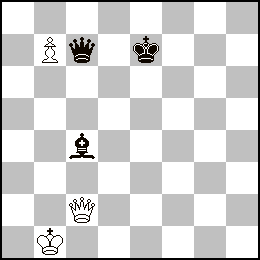The second study is lighter in material but full of pure geometric patterns.
2 - White to play and win

W.: Kb1, Qc2, pb7
B.: Ke7, Qc7, Bc4
Very clean and pleasing
It was the third and final study that caused concern.
A modern study composed by a former top player.
3 - White to play and win

W.: Kd8, Rg7 and h3, Nb4, pb5 and c5
B.: Ka8, Qc1, Be3, pf7
Again, the second move (as in 1) is hard to find, but after that it goes well.
Today's game shows how to slaughter great players.
4 - game of the day
1. d4 Nf6 2. c4 e6 3. Nc3 Bb4 4 e3 (4. Qc2 is more "modern") 0-0 Bd3 d5 6. Nf6 c5 0-0 cd (dc 8 Bxc4 Nbd7 is another way to play) 8. ed dc 9. Bxc4 b6 (A good example of absolute transposition is 1. e4 c6 2. d4 d5 3. ed cd 4. c4 e6 5. Nc3 Nf6 6. Nf3 Bb4 7. Bd3 dc 8. Bxc4 0-0 9 0-0 b6) 10. Bg5 Bb7 11. Re1 Nbd7 (Bxe3 12. bc Nbd7 13. Bd3 Rc8 14. Rc1 Qc7 15. Bh4) 12. Rc1 Rc8 13. Qb3 Be7 (Bxc3 14. Rxc3 h6 (! Boudre) 15. Bh4 Rc7 16. Ne5 Nxe5 ! 17. de Qxd4 !) 14. Bxf6 Nxf6 (Bxf6 15. Nb5 Bxf3 16. Qxf3 a6 17. Nd6 Rc7 18. Nxf7 Rxf7 19. Bxe6 Nf8 20. Rxc7 with relative equality) 15. Bxe6 fe ? (Rc7! 16. Ng5 Qxd4 17. Nxf7 Bc5 18. Nd8+ Kh8 Nxb7 probable draw) 16. Qxe6+ Kh8 17. Qxe7 Bxf3 18. gf Qxd4 19. Nb5 Qxb2 20. Rxc8 Rxc8 21. Nd6 Rb8 22. Nf7+ Kg8 23 Qe6 (small threat) Rf8 24. Nd8+ Kh8 25. Qe7 resigns (I did not note the variation 21. ... Ra8 )
At the table, the Master made a timid gesture towards his pocket to extract a diagram to present, but unfortunately, the PGs of the provocative contest not allowed him to speak.
It remains for me to wish you all a good reading and to give you an appointment on March 3rd, that is to say in 4 weeks with perhaps a change of address at the end.
Yours sincerely
Le greffier
Add a comment